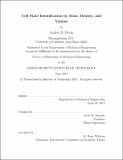Cell State Identication by Mass, Density, and volume
Author(s)
Bryan, Andrea K. (Andrea Kristine)
DownloadFull printable version (16.26Mb)
Other Contributors
Massachusetts Institute of Technology. Dept. of Biological Engineering.
Advisor
Scott R. Manalis.
Terms of use
Metadata
Show full item recordAbstract
Cell size is often overlooked in the drive to define molecular mechanisms, but as a basic physical property it is an integrator of the cell's metabolic rate and indicator of cell fate. Development of the Suspended Microchannel Resonator (SMR), a microfluidic mass measurement system, enables femtogram cell mass resolution, and the resistive pulse (Coulter) technique provides high-speed electronic readout of cell volume. With these tools, we developed four methods to measure cell density, the ratio of mass to volume. We first measure the average density of cell populations using the SMR and a Coulter counter. We observe that cell density increases prior to bud formation at the G1/S transition of budding yeast, which is consistent with previous measurements using density gradient centrifugation. To investigate the origin of this density increase, we use the SMR to measure buoyant mass in high density media and monitor relative density changes of growing yeast cells. We find that the density increase requires energy, function of the protein synthesis regulator TOR, passage through START, and an intact actin cytoskeleton. These techniques are suitable for most non-adherent cells and subcellular particles to characterize cell growth in a variety of applications. We next develop two platforms to measure single-cell mass, volume, and density. These properties are calculated from two SMR buoyant mass measurements, each in different density fluids. These measurements are achieved by serially connecting two SMR structures through a microchannel with an intermediate T-junction, such that a cell is measured by each SMR in different density fluids. Similar measurements can also be made with one SMR by reversing the SMR fluid flow after a cell is measured-each cell re-enters the SMR in a higher density fluid for a second measurement. We find that the intrinsic cell-to-cell density variation is nearly 100-fold smaller than the mass or volume variation, and by simultaneously measuring density and mass, we identify distinct subpopulations of diseased and healthy cells that are indistinguishable by mass or volume alone.
Description
Thesis (Ph. D.)--Massachusetts Institute of Technology, Dept. of Biological Engineering, 2011. This electronic version was submitted by the student author. The certified thesis is available in the Institute Archives and Special Collections. Cataloged from student submitted PDF version of thesis. Includes bibliographical references (p. 119-124).
Date issued
2011Department
Massachusetts Institute of Technology. Department of Biological EngineeringPublisher
Massachusetts Institute of Technology
Keywords
Biological Engineering.